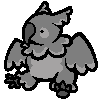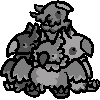Brood Type
|
“Brood types are known to make their own “nests” where there are none available, though these can take just about any form.” | ID: 0204 |
| Type: Brood | |
| Category: Creature | |
| Height: 4 inches (each). | |
| Max Health: GOOD (5) (each) | |
| Ability: EMPTY NEST Brood types will have the urge to seek out a safe place for their group to hide in when threatened, and influence those around them to do the same, regardless of their typing. |
|
| Physical Appearance: Brood types have a short, round build, and are covered in fluffy rounded feathers. On top of their head are two feathered ear nubs that curve up and backwards, the tips being marked. They have a curved down beak in the center of their face, that's short but takes up roughly half the space, on each side sitting a small eyespot with a circular marking around it. Their cheeks have a small bit of feather fluff, their neck also being fluffy, all with the edges being marked. They have two short wings, both with markings on the tips of the feathers, and a lumpy circular marking on their stomach. The top portion of their leg is covered in marked feather fluff, the lower portion being bird legs with three toes. There is no noticeable difference between the cats that make the brood type besides colors. | |
| Voice: Loud chirps and cooing. | |
| External: Standard skin, covered by soft fluffy feathers on most of the body and legs that feel scaly and tough. | |
| Internal: Standard Fluid. | |
| Special Attributes: None. | |
| Other Notes: Brood Types can adapt to many environments, with rural and suburban places being more common. Trees are very important for them. Something that is important to keep in mind with brood types is that they are separate cats, with different interests and preferences, even with some overlaps. A lot of brood types like building, with natural materials usually, which can also lean into art. Some enjoy activities like sports or games but are often blocked from doing it professionally as their group status is considered an unfair advantage. Brood types are social naturally, leaning on each other or other bird types. Brood types seem to have preferences for berry food types, seeds, and bread, but individual preferences are harder to predict. Brood types will repeat words and phrases at each other in mimicked voices, often encouraging each other to say worse things. |
Official Documentation
Documented Cases
Unconfirmed Sightings
Designed by Ringor Mortis. ©2018











